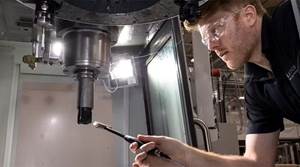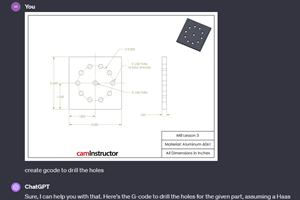Acu-Rite Reinvents Its Products And Its Processes
It's a brave company that makes the commitment to obsolete its current product line and bring on-line a new one. As of September first, that's exactly what Acu-Rite (Jamestown, New York) will do. A leading manufacturer of digital readouts (DRO) for thirty years, the company decided in 1995 to begin a process that would replace the entire product line in a single stroke.
Share






It's a brave company that makes the commitment to obsolete its current product line and bring on-line a new one. As of September first, that's exactly what Acu-Rite (Jamestown, New York) will do.
A leading manufacturer of digital readouts (DRO) for thirty years, the company decided in 1995 to begin a process that would replace the entire product line in a single stroke. Instead of adding and deleting a model at a time, a new product line supplanted the old product line in total.
The company didn't do this changeover in a vacuum. Input for virtually every aspect of new product development came from those who used Acu-Rite DROs and those who sell them.
Phase one of the product redesign began with surveys to end-users and distributors. Over 50 carefully crafted questions were used to elicit what customers and dealers really needed from DRO systems on their machine tools.
One interesting discovery during the information gathering phase was that customer preferences for certain feature packages were sometimes very different than the dealer's perception of what the customers wanted.
Phase two of information gathering was to telephone interview responders randomly selected from returned surveys. The idea was to get supporting information to expand on written responses in order to better understand the rationale behind survey answers. Market research for development of Acu-Rite's new line took over ten months to complete.
Once the new product was defined conceptually, it became a project of retooling the manufacturing operation to build the new products. An investment of over $5 million in research and development and capital equipment has resulted in a more efficient manufacturing operation.
From the R&D side, wringing costs out of the DRO products without compromising features and benefits that customers want. Much of the cost reduction has come from designing for manfacturability and automating the manufacturing process.
Numerous component assemblies for the DROs have been simplified. In one example a connector for the armor cable was simplified by reducing the number of parts that had to be used from eight to two.
In another case, protective coatings for the electronic components were made from epoxy and required a 24-hour cure time. An ultra-violet curing system sets up the newer conformal coating in 40 seconds.
Three new base DRO units and a new glass scale emerged from Acu-Rite's efforts. These products are designed to provide an answer to the most requested DRO feature which is ease of use.
All units have sealed, 3D tactile keypads that provide positive confirmation that a button has been pushed. The case for the DRO is die cast aluminum to better hold up to the rigors of the shop floor.
A base unit, DRO 100, has 2-axis capability and is designed for grinding and general-purpose applications. It contains capabilities that are matched to the needs of shops who want an accurate, basic DRO.
The DRO 200 series gets more application specific. It is designed for milling, turning, grinding and EDM. Each of these DROs has a feature set aimed directly at the task to be performed making the units easier to operate because what a shop needs for a process it has-no more, no less.
For more complex applications in milling and turning, the VRO 300 is available with one- to six-axis capability. VRO stands for vision readout because this model uses a nine-inch CRT for display. Conversational programming walks operators through readout functions using prompts.
According to Acu-Rite, a new capability for glass scales makes its debut with the DRO 100, 200 and VRO 300. Called Position-Trac, it simplifies location of workpiece zero by eliminating time-consuming setups after power interruption to the machine and readout.
A new glass scale, ENC-150, has been added to the line. This scale represents a 30 percent reduction in components yet has increased accuracy over equivalent scales.
These new scales are made for lathes, mills, grinders and EDM machines. Lengths of 2 inches to 120 inches are available with resolutions from 0.5 mm, to 10 mm, and with an accuracy of 5 mm/m.
In addition to the new products and manufacturing process changes, Acu-Rite has reduced its DRO package prices. These reductions are possible because the Acu-Rite people who sell the company's products and the people who make the products decided in earnest to see what they could do together. Maybe there's a lesson in this for your business.
Related Content
How this Job Shop Grew Capacity Without Expanding Footprint
This shop relies on digital solutions to grow their manufacturing business. With this approach, W.A. Pfeiffer has achieved seamless end-to-end connectivity, shorter lead times and increased throughput.
Read MoreCan AI Replace Programmers? Writers Face a Similar Question
The answer is the same in both cases. Artificial intelligence performs sophisticated tasks, but falls short of delivering on the fullness of what the work entails.
Read MoreHow to Mitigate Chatter to Boost Machining Rates
There are usually better solutions to chatter than just reducing the feed rate. Through vibration analysis, the chatter problem can be solved, enabling much higher metal removal rates, better quality and longer tool life.
Read MoreCan ChatGPT Create Usable G-Code Programs?
Since its debut in late 2022, ChatGPT has been used in many situations, from writing stories to writing code, including G-code. But is it useful to shops? We asked a CAM expert for his thoughts.
Read MoreRead Next
AMRs Are Moving Into Manufacturing: Considerations for Implementation
AMRs can provide a flexible, easy-to-use automation platform so long as manufacturers choose a suitable task and prepare their facilities.
Read MoreLast Chance! 2025 Top Shops Benchmarking Survey Still Open Through April 30
Don’t miss out! 91ÊÓƵÍøÕ¾ÎÛ's Top Shops Benchmarking Survey is still open — but not for long. This is your last chance to a receive free, customized benchmarking report that includes actionable feedback across several shopfloor and business metrics.
Read MoreMachine Shop MBA
Making Chips and 91ÊÓƵÍøÕ¾ÎÛ are teaming up for a new podcast series called Machine Shop MBA—designed to help manufacturers measure their success against the industry’s best. Through the lens of the Top Shops benchmarking program, the series explores the KPIs that set high-performing shops apart, from machine utilization and first-pass yield to employee engagement and revenue per employee.
Read More





















